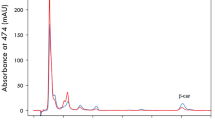Abstract
Phaffia rhodozyma cells were treated with the mutagenic agent NTG several times and plated on yeast-malt agar containing β-ionone as a selective medium. This mutagenesis of the yeast yielded a mutant (NCHU-FS501) with a total carotenoid content of 1454 μg g−1 dry biomass. Temperature and pH had only a slight effect on the volumetric pigment production by the red yeast, however astaxanthin yield and specific growth rate were influenced more significantly by temperature and pH. The optimum inoculum size, temperature and air flow rate for astaxanthin formation by the mutant in a bench-top fermentor were 7.5% (v/v), 22.5°C and 3.6 vvm, respectively. Glucose (1%, w/v) as carbon source yielded the highest volumetric astaxanthin production (6.72 μg ml−1). Peptone (15.8% total nitrogen) was the best nitrogen source for astaxanthin production (6.72 μg ml−1). Pigment formation by the mutant was further improved by increasing the glucose concentration to 3.5%, where the astaxanthin concentration was 16.33 μm ml−1. At 4.5% glucose or above astaxanthin formation was inhibited. Control of the pH of the fermentation broth did not improved pigment production.
Similar content being viewed by others
References
An G-H, DB Schuman and EA Johnson. 1989. Isolation ofPhaffia rhodozyma mutants with increased astaxanthin content. Appl Environ Microbiol 55: 116–124.
Brooks JR and VK Griffin. 1986. A modified method for total carbohydrate analysis of glucose syrups, maltodextrins, and other starch hydrolysis products. Cereal Chem 63: 465–466.
Chien Y-H and S-C Jeng. 1992. Pigmentation of Kuruma prawn,Penaeus japonicus bate, by various pigment sources and levels of feeding regimes. Aquaculture 102: 333–346.
Fang TJ and Y-S Cheng. 1992. Isolation of astaxanthin over-producing mutants ofPhaffia rhodozyma and their fermentation kinetics. Chinese J Microbiol Immunol 25: 209–222.
Fang TJ and Y-S Cheng. 1993. Improvement of astaxanthin production byPhaffia rhodozyma through mutation and optimization of culture conditions. J Ferment Bioeng 75: 466–469.
Haan A, RM Burke and JAM de Bont. 1991. Microbial production of food colorants. Med Fac Land Rijsuniv Gent 56: 1655–1660.
Helwing JF and KA Concil. 1989. SAS/STAT user's guide, version 6, 4th edn, vol 1, SAS Institute Inc, Cary NC.
Johnson EA and G-H An. 1991. Astaxanthin from microbial sources. Crit Rev Biotechnol 11: 297–326.
Johnson EA, DE Conklin and MJ Lewis. 1977. The yeastPhaffia rhodozyma as a dietary pigment source for salmonoids and crustaceans. J Fish Res Bd Canada 34: 2417–2421.
Johnson EA and MJ Lewis. 1979. Astaxanthin formation by the yeastPhaffia rhodozyma. J Gen Microbiol 115: 173–183.
Johnson EA, TG Villa and MJ Lewis. 1980.Phaffia rhodozyma as an astaxanthin source in salmonoid diets. Aquaculture 20: 123–134.
Lewis MJ, N Ragot, MC Berlant and M Miranda. 1990. Selection of astaxanthin-overproducing mutants ofPhaffia rhodozyma with β-ionone. Appl Environ Microbiol 56: 2944–2945.
Lin TF and AL Demain. 1991. Effect of nutrition ofMonascus sp on formation of red pigments. Appl Microbiol Biotechnol 36: 70–75.
Meyer PS and JC du Preez. 1994. Effect of culture conditions on astaxanthin production by a mutant ofPhaffia rhodozyma in batch and chemostat culture. Appl Microbiol Biotechnol 40: 780–785.
Meyer PS, JC du Preez and SG Kilian. 1993. Selection and evaluation of astaxanthin-overproducing mutants ofPhaffia rhodozyma. World J Microbiol Biotechnol 9: 514–520.
Miller GL. 1959. Use of dinitrosalicylic acid reagent for determination of reducing sugar. Anal Chem 31: 426–428.
Nakazoe J. 1982. Application of high performance liquid chromatography to the analysis of carotenoid pigments. Bull Jap Soc Sci Fish 48: 1007–1010.
Nelis HJ and AP De Leenheer. 1989. Microbial production of carotenoids other than β-carotene. In: Biotechnology of Vitamins, Pigments and Growth Factors (Vandamme EJ, ed), pp 43–80, Elsevier, London.
Okagbue RN and MJ Lewis. 1984. Use of alfalfa residual juice as a substrate for propagation of the red yeastPhaffia rhodozyma. Appl Microbiol Biotechnol 20: 33–39.
Phaff HJ, MW Miller, M Yoneyama and M Soneda. 1972. A comparative study of the yeast flora associated with trees on the Japanese Islands and on the west coast of North America. In: Proceeding of the 4th IFS: Fermentation Technology Today (Terui G, ed), pp 759–774, Kyoto, Society of Fermentation Technology, Osaka.
Sedmak JJ and SE Grossberg. 1977. A rapid, sensitive and versatile assay for protein using coomassie brilliant blue G250. Anal Biochem 79: 544–552.
Sedmak JJ, DK Weerasinghe and SO Jolly. 1990. Extraction and quantitation of astaxanthin fromPhaffia rhodozyma. Biotechnol Tech 4: 107–112.
Wang DIC, CL Cooney, AL Demain, P Dunnill, AE Humphrey and MD Lilly. 1979. Fermentation and enzyme technology. John Wiley & Sons, New York.
Author information
Authors and Affiliations
Rights and permissions
About this article
Cite this article
Fang, T.J., Chiou, TY. Batch cultivation and astaxanthin production by a mutant of the red yeast,Phaffia rhodozyma NCHU-FS501. Journal of Industrial Microbiology 16, 175–181 (1996). https://doi.org/10.1007/BF01570001
Received:
Accepted:
Issue Date:
DOI: https://doi.org/10.1007/BF01570001




